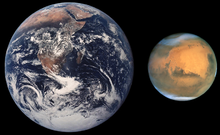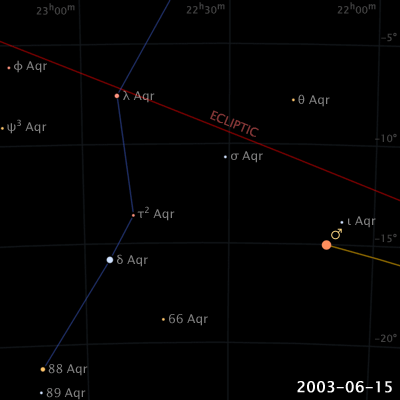Mars is currently host to five functioning spacecraft: three in orbit—the Mars Odyssey, Mars Express, and Mars Reconnaissance Orbiter; and two on the surface—Mars Exploration Rover Opportunity and the Mars Science Laboratory Curiosity. Defunct spacecraft on the surface include MER-A Spirit, and several other inert landers and rovers, both successful and unsuccessful, such as the Phoenix lander, which completed its mission in 2008. Observations by NASA's now-defunct Mars Global Surveyor show evidence that parts of the southern polar ice cap have been receding.[22] Observations by the Mars Reconnaissance Orbiter have revealed possible flowing water during the warmest months on Mars.[23]
Mars can easily be seen from Earth with the naked eye. Its apparent magnitude reaches −3.0,[7] which is only surpassed by Jupiter, Venus, the Moon, and the Sun. Optical ground-based telescopes are typically limited to resolving features about 300 km (186 miles) across when Earth and Mars are closest, because of Earth's atmosphere.
Physical characteristics

Size comparison of Earth and Mars.
Internal structure
Like Earth, this planet has undergone differentiation, resulting in a dense, metallic core region overlaid by less dense materials.[27] Current models of the planet's interior imply a core region about 1794 ± 65 km in radius, consisting primarily of iron and nickel with about 16–17% sulfur.[28] This iron sulfide core is partially fluid, and has twice the concentration of the lighter elements that exist at Earth's core. The core is surrounded by a silicate mantle that formed many of the tectonic and volcanic features on the planet, but now appears to be dormant. Besides silicon and oxygen, the most abundant elements in the martian crust are iron, magnesium, aluminum, calcium, and potassium. The average thickness of the planet's crust is about 50 km, with a maximum thickness of 125 km.[29] Earth's crust, averaging 40 km, is only one third as thick as Mars's crust, relative to the sizes of the two planets. The InSight lander planned for 2016 will use a seismometer to better constrain the models of the interior.Surface geology
Main article: Geology of Mars

Global mosaic of Mars from data gathered by the Viking 1 orbiter in 1980, showing Valles Marineris (center)
Although Mars has no evidence of a current structured global magnetic field,[34] observations show that parts of the planet's crust have been magnetized, and that alternating polarity reversals of its dipole field have occurred in the past. This paleomagnetism of magnetically susceptible minerals has properties that are very similar to the alternating bands found on the ocean floors of Earth. One theory, published in 1999 and re-examined in October 2005 (with the help of the Mars Global Surveyor), is that these bands demonstrate plate tectonics on Mars four billion years ago, before the planetary dynamo ceased to function and the planet's magnetic field faded away.
During the Solar System's formation, Mars was created as the result of a stochastic process of run-away accretion out of the protoplanetary disk that orbited the Sun. Mars has many distinctive chemical features caused by its position in the Solar System. Elements with comparatively low boiling points such as chlorine, phosphorus and sulphur are much more common on Mars than Earth; these elements were probably removed from areas closer to the Sun by the young star's energetic solar wind.
After the formation of the planets, all were subjected to the so-called "Late Heavy Bombardment". About 60% of the surface of Mars shows a record of impacts from that era,[37][38][39] while much of the remaining surface is probably underlain by immense impact basins caused by those events. There is evidence of an enormous impact basin in the northern hemisphere of Mars, spanning 10,600 km by 8,500 km, or roughly four times larger than the Moon's South Pole – Aitken basin, the largest impact basin yet discovered.[15][16] This theory suggests that Mars was struck by a Pluto-sized body about four billion years ago. The event, thought to be the cause of the Martian hemispheric dichotomy, created the smooth Borealis basin that covers 40% of the planet.[40][41]
The geological history of Mars can be split into many periods, but the following are the three primary periods:[42][43]
- Noachian period (named after Noachis Terra): Formation of the oldest extant surfaces of Mars, 4.5 billion years ago to 3.5 billion years ago. Noachian age surfaces are scarred by many large impact craters. The Tharsis bulge, a volcanic upland, is thought to have formed during this period, with extensive flooding by liquid water late in the period.
- Hesperian period (named after Hesperia Planum): 3.5 billion years ago to 2.9–3.3 billion years ago. The Hesperian period is marked by the formation of extensive lava plains.
- Amazonian period (named after Amazonis Planitia): 2.9–3.3 billion years ago to present. Amazonian regions have few meteorite impact craters, but are otherwise quite varied. Olympus Mons formed during this period, along with lava flows elsewhere on Mars.
Search for life
Main articles: Life on Mars|Life on Mars (planet)|Life on Mars and Viking spacecraft biological experiments

The Viking 1 Lander sampling arm created a number of deep trenches as
part of the surface composition and biology experiments. The digging
tool on the sampling arm (lower center) could scoop up samples of
material and deposit them into the appropriate experiment. Some holes
were dug deeper to study soil which was not affected by solar radiation
and weathering. (Chryse Planitia)
The lack of a magnetosphere and extremely thin atmosphere of Mars are a challenge: the planet has little heat transfer across its surface, poor insulation against bombardment of the solar wind and insufficient atmospheric pressure to retain water in a liquid form (water instead sublimates to a gaseous state). Mars is also nearly, or perhaps totally, geologically dead; the end of volcanic activity has apparently stopped the recycling of chemicals and minerals between the surface and interior of the planet.[132]
Evidence suggests that the planet was once significantly more habitable than it is today, but whether living organisms ever existed there remains unknown. The Viking probes of the mid-1970s carried experiments designed to detect microorganisms in Martian soil at their respective landing sites and had positive results, including a temporary increase of CO2 production on exposure to water and nutrients. This sign of life was later disputed by some scientists, resulting in a continuing debate, with NASA scientist Gilbert Levin asserting that Viking may have found life. A re-analysis of the Viking data, in light of modern knowledge of extremophile forms of life, has suggested that the Viking tests were not sophisticated enough to detect these forms of life. The tests could even have killed a (hypothetical) life form.[133] Tests conducted by the Phoenix Mars lander have shown that the soil has a very alkaline pH and it contains magnesium, sodium, potassium and chloride.[134] The soil nutrients may be able to support life, but life would still have to be shielded from the intense ultraviolet light.[135]
At the Johnson Space Center lab, some fascinating shapes have been found in the meteorite ALH84001, which is thought to have originated from Mars. Some scientists propose that these geometric shapes could be fossilized microbes extant on Mars before the meteorite was blasted into space by a meteor strike and sent on a 15 million-year voyage to Earth. An exclusively inorganic origin for the shapes has also been proposed.[136]
Small quantities of methane and formaldehyde recently detected by Mars orbiters are both claimed to be hints for life, as these chemical compounds would quickly break down in the Martian atmosphere.[137][138] It is remotely possible that these compounds may instead be replenished by volcanic or geological means such as serpentinization.[119]
Habitability
The German space agency discovered Earth lichens to survive in simulated Mars conditions.[139] The simulation based temperatures, atmospheric pressure, minerals, and light on data from Mars probes.[139] An instrument called REMS is designed to provide new clues about signature of the Martian general circulation, microscale weather systems, local hydrological cycle, destructive potential of UV radiation, and subsurface habitability based on ground-atmosphere interaction;[140][141] it landed on Mars as part of Curiosity (MSL) in August 2012. Microrganisms make up 80% of Earth's biomass.[139]Exploration missions
Main article: Exploration of Mars
In addition to observation from Earth, some of the latest Mars
information comes from five active probes on or in orbit around Mars
including three orbiters and two rovers. This includes 2001 Mars Odyssey,[142] Mars Express, Mars Reconnaissance Orbiter, Opportunity rover, and Curiosity rover.Dozens of unmanned spacecraft, including orbiters, landers, and rovers, have been sent to Mars by the Soviet Union, the United States, Europe, and Japan to study the planet's surface, climate, and geology. The public can request images of Mars via the HiWish program.
The Mars Science Laboratory, named Curiosity, launched on November 26, 2011, reached Mars on August 6, 2012 UTC. It is larger and more advanced than the Mars Exploration Rovers, with a movement rate up to 90 meters per hour (295 feet per hour).[143] Experiments include a laser chemical sampler that can deduce the make-up of rocks at a distance of 7 meters.[144]
Astronomy on Mars
Main article: Astronomy on Mars
With the existence of various orbiters, landers, and rovers, it is now possible to study astronomy from the Martian skies. While Mars's moon Phobos appears about one third the angular diameter
of the full Moon as it appears from Earth, Deimos appears more or less
star-like, and appears only slightly brighter than Venus does from
Earth.[145]There are various phenomena, well-known on Earth, that have been observed on Mars, such as meteors and auroras.[146] A transit of the Earth as seen from Mars will occur on November 10, 2084.[147] There are also transits of Mercury and transits of Venus, and the moons Phobos and Deimos are of sufficiently small angular diameter that their partial "eclipses" of the Sun are best considered transits (see Transit of Deimos from Mars).[148][149]
Viewing
Because the orbit of Mars is eccentric, its apparent magnitude at opposition from the Sun can range from −3.0 to −1.4. The minimum brightness is magnitude +1.6 when the planet is in conjunction with the Sun. Mars usually appears a distinct yellow, orange, or reddish color; the actual color of Mars is closer to butterscotch, and the redness seen is just dust in the planet's atmosphere; considering this, NASA's Spirit rover has taken pictures of a greenish-brown, mud-colored landscape with blue-grey rocks and patches of light red colored sand. When farthest away from the Earth, it is more than seven times as far from the latter as when it is closest. When least favorably positioned, it can be lost in the Sun's glare for months at a time. At its most favorable times—at 15- or 17-year intervals, and always between late July and late September—Mars shows a wealth of surface detail to a telescope. Especially noticeable, even at low magnification, are the polar ice caps.As Mars approaches opposition, it begins a period of retrograde motion, which means it will appear to move backwards in a looping motion with respect to the background stars. The duration of this retrograde motion lasts for about 72 days, and Mars reaches its peak luminosity in the middle of this motion.



No comments:
Post a Comment